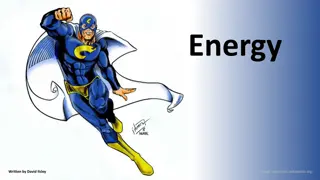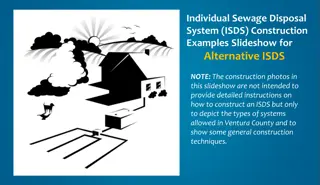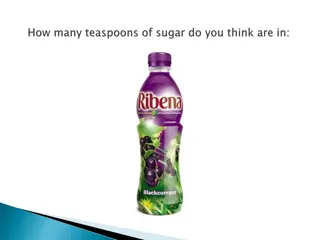
Understanding Plant Science in Agriculture
Explore the importance of plant science in agriculture, focusing on major crops in Oklahoma, crop production, economic impacts, and the significance of agronomy. Learn about common crops, conditions for optimal growth, and the economic contributions of crop production to Oklahoma's economy.
Download Presentation

Please find below an Image/Link to download the presentation.
The content on the website is provided AS IS for your information and personal use only. It may not be sold, licensed, or shared on other websites without obtaining consent from the author. If you encounter any issues during the download, it is possible that the publisher has removed the file from their server.
You are allowed to download the files provided on this website for personal or commercial use, subject to the condition that they are used lawfully. All files are the property of their respective owners.
The content on the website is provided AS IS for your information and personal use only. It may not be sold, licensed, or shared on other websites without obtaining consent from the author.
E N D
Presentation Transcript
Orientation to Agriculture in Society Unit 3: Plant Science in Agriculture
Major Agricultural Crops in Oklahoma Unit 3 Lesson 1
Lesson 1 Objectives List and describe common crops in Oklahoma Explain the important conditions needed to produce crops Predict crop health when growing conditions don't align with what a crop needs
What is a Crop? Crops Crops are plants that are grown to make a profit Harvested for food, fiber, fuel, or other products. Main uses of crops: Food crops Food crops Wheat, corn, soybeans Fiber crops Fiber crops Cotton, flax Oilseed Crops Oilseed Crops Soybean
Agronomy Agronomy Agronomy is the science of growing crops and improving soil. Agronomists Focus on soil health soil health Manage crops Manage crops Improve growing conditions Study crops
Economic Impact of Crops Crop production has a large impact on Oklahoma's economy $1,814,557,000 in cash receipts for crops in 2023 Wheat Wheat = $669,649,000 Cotton Cotton = $282,165,000 Oklahoma crops are sold across the U.S. and even overseas Thousands Thousands of Oklahomans have jobs connected to crop farming economy
Crop Production in Oklahoma Top crops in Oklahoma, based on acres of production: Wheat (4.25 million acres) Bread Bread, cereal, animal feed Hay (3.36 million acres) Livestock feed Cotton Cotton Textiles, cottonseed oil Sorghum (414,000 acres) Livestock feed, can be used like wheat Soybeans (385,000 acres) Oil Oil, protein food, livestock feed
Wheat Used to make flour Key ingredient in breads Cereal Crop We harvest and process the seeds Economic Importance in Oklahoma $504,210,000 value 3rd 3rd in country for production of wheat 4.25 4.25 million acres of wheat in 2025 Top counties for production are: Garfield Garfield, Grant, Alfalfa, Kay flour breads, pastas, cakes, and more seeds to make food Kay, Caddo
Hay Dried grass Grass is cut A round bale usually weighs between 600-2000 lbs Economic Importance in Oklahoma 615,315,000 value 7th 7th in country for hay production 3.36 3.36 million acres of hay in 2025 grass or legumes legumes, primarily used as feed for livestock cut, dried dried out, and baled baled
Cotton Used to create textiles for clothing, bedding, and other fabrics Harvested from a plant's bolls Cotton grown in the US is mostly upland cotton Economic Importance in Oklahoma 274,000 bales of cotton produced in 2023 in Oklahoma $284 $284 million value Oklahoma ranks 6th 6th in cotton production Top counties for production are: Jackson, Tillman Tillman, Harmon, Washita, Kiowa Kiowa
Sorghum Important feed Disease Disease and damage tolerant, drought tolerant Economic Importance in Oklahoma Oklahoma ranks 3rd 3rd in total production 414,000 414,000 acres dedicated to production 12,000,000 acres produced Top counties for production are: Texas Texas, Kay, Beaver, Grant Grant, Garfield feed for livestock like cattle drought tolerant
Soybean Legume that produces edible seeds High in protein protein and oil content Used as food food, livestock feed, fuel, oil Tofu, biodiesel biodiesel, paints, and haircare Economic importance to Oklahoma $90 million value 24th 24th in total production 335,000 acres planted in 2023 6.5 6.5 million bushels in 2023 Top counties for production are: Kay, Wagoner Wagoner, Grant, Muskogee, Ottawa edible seeds oil, and fiber haircare products all come from soybeans Ottawa
Growing Conditions of Crops Crops need certain good growing conditions to grow healthy strong strong Growing conditions: Good soil Water Water Sunlight Space Temperature Temperature Producers match the conditions conditions in their area with crops that will thrive Farmers must manage manage the needs of crops to get the most healthy and thrive most out of them
Sunlight Plants use sunlight Process called photosynthesis Different crops need different amounts of light. Corn and cotton = Full sun Full sun (6 8+ hours) Lettuce and spinach = Can grow with partial shade When plants don't get enough sun Slow growth Weak stems Fewer flowers/fruit Yellow or pale leaves sunlight to help produce food (sugars photosynthesis sugars) in the plant partial shade
Water What does water do for the plant? Helps move nutrients nutrients from soil to plant Important in food production food production for the plant Keeps plants firm firm Regulates temperature temperature Issues with water Too much = root rot, disease, fungus Too little = wilted or dead plants, poor production Farmers use irrigation systems irrigation systems to water crops in dry areas like Western estern Oklahoma Crops have different water needs: Soybeans = medium water Sorghum = drought-tolerant
Soil Soil holds water Soil factors important for plants Texture Texture and structure pH Nutrients Soil Textures Sandy Sandy = drains water quickly Clay = holds water holds water Loam = best mix for most crops water and nutrients nutrients that crops need to grow crops
Crop Rotation and Soil Health Crop rotation Crop rotation Planting different crops each year on a rotational basis Adds nutrients nutrients to soil (like nitrogen from soybeans) Prevents pests pests and disease more common in monocultures Reduces soil erosion erosion Example rotations: Corn, Soybean, Wheat Soybean, Alfalfa, Corn Increases sustainability sustainability for better soil fertility in the long run monocultures
Nutrients 17 essential nutrients for plant growth Each nutrient does something important for the plant Primary Macronutrients Nitrogen Leaf and stem growth Makes amino acids, helps with photosynthesis Phosphorus Healthy root growth Flower, fruit, seed development Potassium Nutrient and water transport Strengthens cell walls and improves stress resistance
Nutrients What happens if a plant doesn't have enough nutrients? Plants exhibit different symptoms symptoms depending on the nutrient deficiency Common symptoms Yellow Yellow leaves, weak weak stems No fruits, poor grain or pod formation formation How do farmers add nutrients? Soil Amendments Manure Manure, compost, fertilizers fertilizers, lime, sulfur deficiency
Temperature Each crop has an ideal temperature range Seeds won't sprout into plants if it's too cold Too cold or hot can kill plants Warm Warm season crops: 70 Cool Cool season crops: 60 F and 75 F All crops have different crop preferences Wheat = cool cool Cotton = hot Corn Corn = warm Tomatoes = hot temperature range cold 70 F F and 85 85 F F
Lesson 1 Review What is crop production? How important are crops to Oklahoma? Which crops are most grown in Oklahoma? Why would certain crops thrive in Oklahoma that fail elsewhere?
Fruits, Vegetables, and Nuts Unit 3 Lesson 2
Lesson 2 Objectives Examine horticultural production in Oklahoma Describe the steps of starting a garden Describe the hardiness zones map and why it is important
Horticulture Horticulture Horticulture is the science of growing: Fruits Vegetables Vegetables Ornamental plants Flowers Landscape plants like trees Crops are typically cultivated on a smaller Many horticultural crops require intensive cultivation trees and shrubs shrubs smaller scale than agronomy cultivation and care care
Horticulture Horticulture encompasses a wide variety of disciplines Pomology Pomology fruit production Olericulture vegetable vegetable production Ornamental horticulture dealing with ornamental Floriculture Floriculture flower and ornamental plant production Landscape Landscape horticulture design and maintenance of landscapes Horticulture also includes gardening gardening on a small scale, like a backyard garden backyard garden disciplines ornamental plants
Types of Plants in Horticulture Fruits Fruits Food high in vitamins Apples, strawberries, peaches Vegetables Vegetables Nutritious food source Lettuce Lettuce, carrots, tomatoes Nuts Nuts High in protein protein, some oil uses Pecans, almonds, cashews vitamins peaches
Types of Plants in Horticulture Flowers Flowers Decoration for inside and outside, pollination Tulips, marigolds, sunflowers Landscape Plants Landscape Plants Shade, decoration decoration, erosion control Shrubs, trees trees, groundcover pollination
Gardening Basics Gardening Gardening is cultivating and caring for plants, typically on a small scale Can include fruits, herbs, vegetables, and flowers Can include areas like a backyard, porch, or even a windowsill If you have access to an area like this, you can be a gardener Gardening is a potential SAE that doesn't require a lot of money Gardening teaches about responsibility, patience, and hard work Could grow your own food or even sell it
Planning Your Garden Important considerations when planning a garden Knowing where where your garden will be Raised bed, container, directly in the ground Knowing what what you will grow Vegetables, flowers, plants Knowing how much space space your plants will need Knowing the sun and nutritionrequirements requirements
Starting a Garden Step 1: Picking a Location Most horticultural plants like vegetables require 6+ hours of sunlight per day Must have good drainage Location should be near a water source Be flexible; Raised beds or containers work too Step 2: Deciding on what to grow If you're a first-time gardener, start with something easy like tomatoes Have a plan for your plants selling, eating them, giving them away Know your hardiness zone some plants do better in our climate than other plants do
Starting a Garden Step 3: Making a Garden Plan Group plants together based on needs Leave space space to walk through and water or weed Draw a map of your garden plan Userows rows or blocks blocks Step 4: Preparing the soil Sometimes, you will need to till This breaks up soil, helps with weed management and prepares it for cultivation Can have negative consequences like erosion Test your soil soil or use compost Break upclumps clumps and remove rocks rocks Mix in organic matter organic matter for nutrients Garden Plan needs soil till your garden erosion as well
Starting a Garden Step 5: Planting Your Seeds or Seedlings Directions on the back of a seed packet When When to plant, how deep Water in gently Steo 6: Caring for Your Plants Water regularly (usually early morning) Pull weeds often Watch for pests or plant diseases Pick your vegetables when ripe seed packet tell you all important information deep to plant, spacing spacing
Tips for Beginner Gardeners Start small (one raised bed or 3 5 containers) Use mulch to keep weeds down and soil moist Label your plants and take notes Learn from your mistakes Just because you don't do it right the first time, doesn't mean shouldn't try again Try a class or community garden to learn more Be patient gardening takes time and care Take pictures of your garden, that helps remind you how much of a difference a week can make
Timing is Everything Plant species grow best with different temperatures Cool season Cool season plants - grow best in cooler temperatures Can sometimes harvest in spring and fall Carrots, peas, broccoli, radish, lettuce Warm season Warm season plants grow best in warmer soil and more sunlight Typically harvest in summer or early fall Tomatoes, peppers, squash, corn Timing Too early frost might kill them Too late heat or drought might stop them from growing temperatures
Common Oklahoma Fruits, Veggies, and Nuts Vegetables: Vegetables: Tomatoes Peppers Lettuce Squash Fruits: Fruits: Strawberries Apples Peaches Nuts: Nuts: Pecans
Hardiness Zones Hardiness Zones tell you what plants can survive in your climate Zones are numbered 1 is the coldest climate 13 is the warmest Each zone represents average minimum winter temperatures Oklahoma is mostly in Zones 6 and 7 Zone 6: Panhandle, northern most parts of state Winter temps as low as -10 F) Zone 7: Southern, western, eastern and central parts of state Winter temps as low as 0 F Seed packets will have information on hardiness zones Tells you when it's safe to plant in spring
Lesson 2 Review What is horticulture? What types of plants are in horticulture? If you were going to start a garden, how would you plan it? Why would knowing a hardiness zone be important?
Ornamental and Landscaping Plants Unit 3 Lesson 3
Lesson 3 Objectives Define ornamental plants and describe their importance Examine floral bed design and care Identify parts of a flower
What are Ornamental Plants? Plants grown for beauty Flowers Shrubs Shrubs Trees Vines Vines Grasses and groundcovers Found in Ornamental trees are found in: Lawns Lawns and gardens City parks, schools schools, and other municipal areas Roadsides Roadsides, building entrances beauty not food or fiber
Value of Ornamental Plants Impact on Oklahoma's Economy ~$1.5 ~$1.5 billion impact Includes industries like flower and nursery wholesaling florists, landscaping Creates Jobs Jobs Landscaping professionals, garden centers, florists, greenhouse growers could be potential employers Potential careers include landscape architect, golf course superintendent, florist Enhance Our Spaces Spaces Make homes, schools, and parks more attractive attractive Improve the visual appeal of neighborhoods neighborhoods and cities Used in landscaping landscaping,bouquets bouquets, and decorations decorations wholesaling, garden stores garden stores, cities
Value of Ornamental Plants Helps the environment environment Reduce air pollution Provides shade shade and cools airs, limiting "heat islands Heat islands are caused by infrastructure that absorb and retain heat, making an urban area hot Support Wildlife and Pollinators Provide food food and shelter shelter for bees, butterflies, birds Many flowers are essential for pollination Pollinators Pollinators are animals that help plants makeseeds They move pollen form one flower to another so plants can reproduce pollution and soil erosion erosion heat islands" in urban areas birds, and other animals reproduce
Value of Ornamental Plants Helps with Mental Health Mental Health and Learning Plants improve focus focus, memory, relaxation, comfort Public garden spaces reduce reduce stress School gardens can even improve student learning Learning student learning
Landscaping Design Basics Landscaping Planning outdoor spaces using: Hardscape Non-living parts (rocks, sidewalks, fences) Softscape Living parts (plants, flowers, trees) A good landscape: Looks nice and flows with surroundings Is easy to take care of Guides movement of humans with borders and walkways Helps the environment (shade, windbreak, erosion control) Provides shade Blocks wind Prevents erosion Supports pollinators
Designing a Simple Flowerbed Step 1: Pick or Assess the Location Sunlight Sunlight most ornamental plants need at least 6 6 hours of sun Travel Travel - Away from pets or foot traffic; might need to divert travel with walkways Water Water No standing water, sogginess or heavy Size Size Measure to determine how big the space will be Shape Shape Design the shape of the flowerbed Step 2: Design Plan Design a map for your flowerbed Include existing features, important focal points, all plants incorporated into design Design Taller plants in the middle or in the back Shorter flowers go along the edges or front Leave room for plant growth Space plants according to the tag Groups of 3's heavy run off after rain
Designing a Simple Flowerbed Step 3: Picking Choose plants that will thrive Consider hardiness Great beginning flowers Sunflowers Sunflowers, marigolds, zinnias, tulips, natives Aesthetic considerations when picking plants: Color Color Heights Heights of mature plants Time of year they bloom Step 4: Preparing the Soil Preparing the soil Remove Remove weeds and grass Loosen Loosen soil Mix in compost compost or new soil if ground is hard, dry, or lacks nutrients Planting Dig holes based on plant size Hole should be 2 2- -3 3 times wider than root ball, no deeper than the root ball Place the plant in the hole, cover with soil, and press gently Water well Use mulch mulch around flowers to retain water and prevent weeds Picking Your Plants thrive in your climate hardiness zones, soil climate and environment soil types, sunlight, sunlight, water natives like coneflowers and Black-eyed Susans bloom Soil and Planting
Tools You Might Need Trowel (small hand shovel) Watering can or hose Gloves Plant markers Rake or hoe Mulch or compost
Caring for Your Flowerbed Your care plan should include: Watering Watering regularly Morning Morning watering is best for plants Pulling weeds Pulling weeds once a week Weeds make the flowerbed look unkept Weeds also take water Deadheading Deadheading (removing old flowers) to keep plants blooming Watching for bugs bugs and signs of disease Using pesticides when necessary Fertilizing Fertilizing or adding nutrients unkept water and nutrients nutrients from the flowers disease
Parts of a Flower Petal Petal Attracts pollinators; colorful and scented Sepal Sepal Small, green leaves under the petals; Protects bud before it opens Male parts of the flower Stamen Stamen Male part of the flower; produces pollen Anther Anther Sticky top of the stamen; holds holds pollen Filament Filament Thin stalk that holds up the anther anther pollen
Parts of a Flower Female Parts of the Flower Pistil Pistil Stigma Stigma Sticky top; catches Style Style Tube-like; Connects stigma to ovary Ovary Ovary Base of the pistil; Eventually becomes fruit Ovule Ovule Ovule turns into the seed catches the pollen fruit or seed pod; holds eggs seed after pollination






















